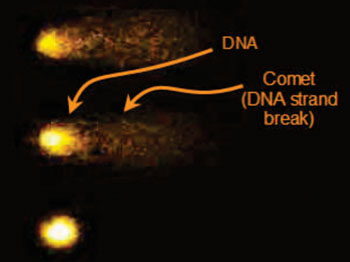Sensitivity of White Blood Cell DNA to Damage from UV Light Distinguishes Cancer Patients from Healthy Individuals
By LabMedica International staff writers
Posted on 14 Aug 2014
A simple test that measures the extent of damage to white blood cell DNA caused by exposure to ultraviolet light has the potential to detect individuals with cancer before the appearance of any detectable symptoms.Posted on 14 Aug 2014
Investigators at the University of Bradford (United Kingdom) recently described the Lymphocyte Genome Sensitivity (LGS) test that they had developed. This test, which is based on "comet assay" technology, evaluates the damage caused to white blood cell DNA by exposure to different intensities of ultraviolet light (UVA).

Image: The single cell gel electrophoresis assay or “comet” test (Photo courtesy of the Belgian BioElectroMagnetics Group).
The comet assay (single-cell gel electrophoresis) is a simple method for measuring DNA strand breaks in eukaryotic cells. Cells embedded in agarose on a microscope slide are dissolved with detergent and a high salt concentration to form nucleoids containing supercoiled loops of DNA linked to the nuclear matrix. Electrophoresis under alkaline conditions results in structures resembling comets, observed by fluorescence microscopy, with the intensity of the comet tail relative to the head reflecting the number of DNA breaks. Determine of the extent of DNA damage is obtained from visual analysis after DNA staining and calculation of fluorescence, which can be performed by manual scoring or automatically by imaging software.
For their study, the investigators looked at lymphocyte responses from 208 individuals: 20 with melanoma, 34 with colon cancer, four with lung cancer, 18 with suspected melanoma, 28 with polyposis, 10 with COPD (chronic obstructive pulmonary disease), and 94 healthy volunteers. Random and anonymous white blood cell samples were exposed to UVA light through five different depths of agar and then analyzed by the comet assay.
Results revealed that damage to DNA in white blood cells from cancer patients reached a stable plateau after treatment with different UVA intensities. In contrast the response of white blood cells from healthy individuals returned to control values.
Dr. Diana Anderson, professor of life sciences at the University of Bradford, said, “White blood cells are part of the body’s natural defense system. We know that they are under stress when they are fighting cancer or other diseases, so I wondered whether anything measurable could be seen if we put them under further stress with UVA light. We found that people with cancer have DNA which is more easily damaged by ultraviolet light than other people, so the test shows the sensitivity to damage of all the DNA—the genome—in a cell.”
“These are early results completed on three different types of cancer, and we accept that more research needs to be done; but these results so far are remarkable,” said Dr. Anderson. "Whilst the numbers of people we tested are, in epidemiological terms, quite small, in molecular epidemiological terms, the results are powerful. We have identified significant differences between the healthy volunteers, suspected cancer patients, and confirmed cancer patients of mixed ages at a statistically significant level. We believe that this confirms the test’s potential as a diagnostic tool.”
The study was published in the July 25, 2014, online edition of FASEB Journal.
Related Links:
University of Bradford














